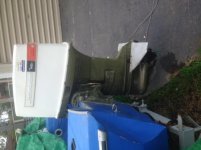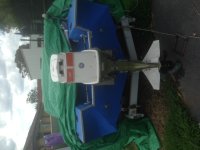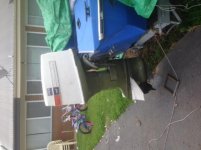Hi,
[FONT=wf_segoe-ui_normal]Was hoping if anyone may have some experience on what may be wrong with my 65ESL72S?[/FONT]
[FONT=wf_segoe-ui_normal] [/FONT]
[FONT=wf_segoe-ui_normal]The motor starts first time almost every time goes into forward and reverse and looks great in a tub or with earmuffs on[/FONT]
[FONT=wf_segoe-ui_normal]but as soon as I take the boat out in the lake it has no power or thrust under load.[/FONT]
[FONT=wf_segoe-ui_normal] [/FONT]
[FONT=wf_segoe-ui_normal]I have checked the prop by drawing a line on the back hub to see if it is slipping and it is not.[/FONT]
[FONT=wf_segoe-ui_normal] [/FONT]
[FONT=wf_segoe-ui_normal]I have also changed the gear oil to a type C which is recommended for the hydroelectric shift.[/FONT]
[FONT=wf_segoe-ui_normal] [/FONT]
[FONT=wf_segoe-ui_normal]The marine mechanics that are in my area in Australia are not experienced at all with this motor at all.[/FONT]
[FONT=wf_segoe-ui_normal] [/FONT]
[FONT=wf_segoe-ui_normal]Any ideas or knowledge you may regarding this issue would be greatly appreciated.[/FONT]
[FONT=wf_segoe-ui_normal] [/FONT]
[FONT=wf_segoe-ui_normal]Was hoping if anyone may have some experience on what may be wrong with my 65ESL72S?[/FONT]
[FONT=wf_segoe-ui_normal] [/FONT]
[FONT=wf_segoe-ui_normal]The motor starts first time almost every time goes into forward and reverse and looks great in a tub or with earmuffs on[/FONT]
[FONT=wf_segoe-ui_normal]but as soon as I take the boat out in the lake it has no power or thrust under load.[/FONT]
[FONT=wf_segoe-ui_normal] [/FONT]
[FONT=wf_segoe-ui_normal]I have checked the prop by drawing a line on the back hub to see if it is slipping and it is not.[/FONT]
[FONT=wf_segoe-ui_normal] [/FONT]
[FONT=wf_segoe-ui_normal]I have also changed the gear oil to a type C which is recommended for the hydroelectric shift.[/FONT]
[FONT=wf_segoe-ui_normal] [/FONT]
[FONT=wf_segoe-ui_normal]The marine mechanics that are in my area in Australia are not experienced at all with this motor at all.[/FONT]
[FONT=wf_segoe-ui_normal] [/FONT]
[FONT=wf_segoe-ui_normal]Any ideas or knowledge you may regarding this issue would be greatly appreciated.[/FONT]
[FONT=wf_segoe-ui_normal] [/FONT]




